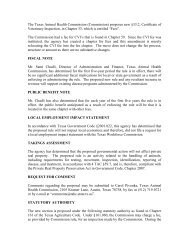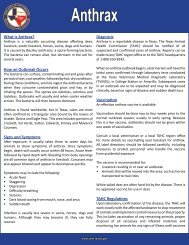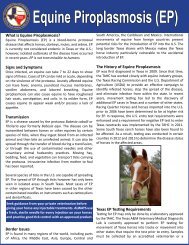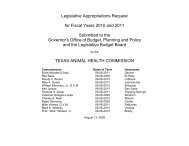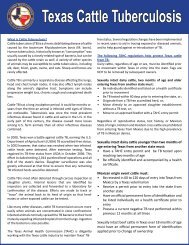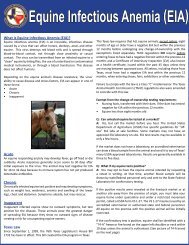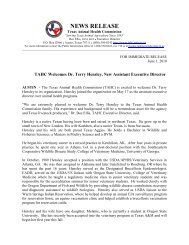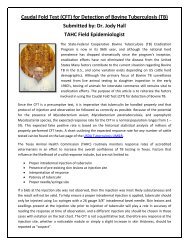Johne's Q&A for Sheep Owners
Johne's Q&A for Sheep Owners
Johne's Q&A for Sheep Owners
- No tags were found...
You also want an ePaper? Increase the reach of your titles
YUMPU automatically turns print PDFs into web optimized ePapers that Google loves.
The National Johne’s Education Initiative recognizes Dr. Elisabeth Patton andDr. Gretchen May with the Wisconsin Department of Agriculture, Trade andConsumer Protection and Dr. Elizabeth Manning with the University ofWisconsin-Madison Johne’s In<strong>for</strong>mation Center <strong>for</strong> their contributions to thispiece. Some photos have been provided by the Johne’s In<strong>for</strong>mation Center,University of Wisconsin-Madison, http://johnes.org.
1Q: What is Johne’s disease?A: Johne’s (“YO-knees”) disease is a fatal gastrointestinal diseaseof sheep and other ruminants (including goats, cattle, elk, deer andbison) caused by the bacterium Mycobacterium avium subspeciesparatuberculosis (MAP). Also known as paratuberculosis, this infectionis contagious and can spread in your fl ock.The MAP organism is most commonly passed in the manure of infectedadult animals. Lambs typically become infected when they swallow water,milk or feed that has been contaminated by manure from infected animals.Most owners are taken by surprise when the infection is diagnosed, andlearn too late that the infection has taken hold in multiple animals in a flock.Due to lack of testing and reporting, it is not known how widespread Johne’sdisease is in sheep in the United States. The infection has been confirmed,however, in many flocks andsheep breeds throughout thecountry, and it is a problemin most other sheep-rearingcountries.The costs of this infection are dueto increased culling and reducedproduction—limited weight gainand poor fleece growth andquality. Flocks that do notaddress the infection may lose upto 10% of adult sheep each year.There is no cure <strong>for</strong> Johne’sdisease. A vaccine that is availablein other countries is notapproved <strong>for</strong> use in sheep inthe United States.Prevention is the key to control.
3Q: Why do animals with clinical signs of Johne’sdisease lose weight and become weak?A: When an animal is infected with MAP, the bacteria reside inthe last part of the small intestine—the ileum—and the intestinal lymphnodes. At some point, the infection progresses as bacteria multiply andtake over more and more of the tissue. The sheep’s immune systemresponds to the MAP with infl ammation that thickens the intestinal walland prevents it from absorbing nutrients. As a result, a sheep in the fi nalstages of Johne’s disease in effect starves to death. At this stage, theorganism may also spread beyond the gastrointestinal tract, travelling inthe blood to muscles or other major organs such as the liver or lungs.Top: Thickened intestinal mucosa caused by Johne’s disease.Bottom: Thin, pliable, normal intestine
4Q: How do sheep become infected?How is MAP spread in a flock?A: Johne’s disease usually enters a fl ock when an infected, buthealthy-looking, sheep is purchased. With MAP hiding in its small intestine,this infected sheep sheds the organism in its pellets onto pasture or intowater shared by its new flockmates.<strong>Sheep</strong>—particularly those less than 6 months old—are at risk as theyrepeatedly swallow the organism. If the ewe is infected, her offspringcan become infected evenbe<strong>for</strong>e they are born(in utero transmission).Since the organism isalso shed in an infectedewe’s milk and colostrum,lambs ingest MAP throughsuckling. Other sourcesof infection are manurestainedteats plus feed,grass or water contaminatedby manure containingMAP.Bottle-fed lambs may alsobecome infected if the milkwas contaminated.Since sheep usually produce more than one lamb per birthing, Johne’sdisease can spread swiftly in a fl ock, especially if the infection remainsundetected in a fl ock <strong>for</strong> several lambing seasons.While lambs are most susceptible to infection, older sheep may becomeinfected, particularly when their immune systems are suppressed <strong>for</strong>other reasons.MAP infection can be transmitted from one ruminant species to another—<strong>for</strong> example from cows to sheep, sheep to goats, etc.
7Q: How can I control Johne’s disease once it hasentered in my flock?A: Since there is no cure <strong>for</strong> Johne’s disease, control of theinfection is critical. Control of Johne’s disease takes time and a strongcommitment to management practices focused on keeping younganimals away from contaminated manure, milk, feed and water. A typicalfl ock clean-up program may take a number of years.The basics of control are simple: New infections must be prevented, andanimals with the infection must be identifi ed and removed from the fl ock.Your State Designated Johne’s Coordinator can help you undertake anon-farm risk assessment that evaluates your operation, your resourcesand your goals. This on-farm risk assessment highlights current managementpractices that may put your flock at risk <strong>for</strong> spreading Johne’sdisease and other infections. At the completion of a risk assessment, yourveterinarian can work with you to develop a management plan designedspecifically <strong>for</strong> you and your flock that will minimize the identified risks<strong>for</strong> disease transmission. (Risk assessment is discussed as part of theJohne’s disease course <strong>for</strong> sheep producers at www.vetmedce.org.)Most control plans follow basic rules of sanitation to block transmissionof the infection within the fl ock. Management recommendations include:● Prepare “low risk” lambing and weaning paddocks that areused only <strong>for</strong> sheep believed to be free of infection. (Sixweeks destocking of a premises can dramatically reducecontamination levels.)● Lamb suspect or test-positive ewes in an area separate fromlow-risk ewes.● Fence off wet and low-lying areas so young animals do notgraze these areas.● Cull clinically ill or test-positive animals as soon as possible,and consider culling the most recently born lambs of theseewes as well.
9Q: How can I clean equipment, sheds or fieldspotentially contaminated with MAP?A: The MAP organism is very hardy in the environment: It resistsheat, cold, drying and dampness. Although the majority of organisms dieafter several months, some may remain <strong>for</strong> a year or more. In fact,research shows that MAP can survive—at low levels—<strong>for</strong> up to 11months in soil and 17 months in water. MAP has also been recoveredfrom grasses fertilized with MAP-contaminated manure. This is whypastures and fi elds known to be contaminated with MAP should not begrazed by lambs, calves or kids <strong>for</strong> at least one year after last exposure.Feed and watering equipment that may have become contaminated withMAP should be washed and rinsed. When cleaning a water trough,sediment and slime from the sides and bottom should not be dumpedonto ground that will be grazed by young sheep.Disinfectants labeled as “tuberculocidal” may be used as directed <strong>for</strong>cleaning tools, implements and some surfaces. These disinfectants,however, are inactivated by organic material—such as dirt and manure—and are there<strong>for</strong>e not effective on dirty surfaces, wood surfaces, soil oreven cement fl oors.Composting of manure and used bedding can reduce the number ofliving MAP organisms they may contain.
10Q: Should I test my flock <strong>for</strong> Johne’s disease?A: If you have sheep with a normal appetite that have become thinand are not responding to treatment, talk to your veterinarian. The culpritmay be Johne’s disease.Remember: Since Johne’s disease is a fl ock problem, testing shouldfocus on the fl ock and not just on a single animal.Diagnostic testing <strong>for</strong> Johne’s disease can help to:1. Determine if MAP infection is present in your flock.2. Estimate the extent of MAP infection in your fl ock.3. Control MAP in an infected fl ock.4. Make a diagnosis <strong>for</strong> a sick animal.5. Check if MAP is present in the environment.6. Meet a pre-purchase or shipping requirement.7. Demonstrate to potential buyers that your animals are low risk<strong>for</strong> Johne’s disease (test negative).Once your veterinarian knows your goals in testing <strong>for</strong> Johne’s disease,a testing plan that best meets your needs can be put in place. This planshould outline the type of test, when to test, which sheep to focus on,the cost of testing, how to interpret the results and what actions to takebased on test results.Decide how you plan to act on your test results be<strong>for</strong>e the samplesare collected.
11Q: What diagnostic tests are available?Which one is best?A: There are a number of effective assays <strong>for</strong> Johne’s diseasetesting in sheep. The best testing program is one developed by you andyour veterinarian since you know your operation best—its goals, resources,other animal health issues.Diagnostic tests <strong>for</strong> Johne’s disease look <strong>for</strong> either the organism thatcauses Johne’s disease (MAP) or the animal’s response to infection.Tests that look <strong>for</strong> the organism in manure include culture and direct PCR.Individual animals canbe tested or a laboratorycan pool manure samplesfrom multiple animals andprovide owners witheffective Johne’s diseasesurveillance <strong>for</strong> a fractionof the cost of individualculture or PCR.The animal’s body eventuallyresponds to MAPinfection by makingantibodies. The test thatmeasures antibody levelsin the blood is the ELISA.Due to the biology of MAPinfection, older, infectedsheep are much morelikely to shed MAP or produceantibody. There<strong>for</strong>e,diagnostic tests are lessreliable <strong>for</strong> most sheepless than 18 months old.
12Testing approaches that have worked well <strong>for</strong> other fl ocks include:Testing Purpose Option A Option BConfirm presence ofMAP in a flock.Determine number ofsheep that are infected.Control or eradicateMAP in an infected flock.Diagnose a sick sheep(weight loss and/ordiarrhea).Culture 5 – 10environmental fecalsamples collected athigh sheep traffi c areas.Blood test (ELISA*) alladult sheep.Blood test (ELISA*)sheep after their secondlambing or older.If previous cases havebeen seen in the fl ock:ELISA*. (Fecal cultureif CLA is a problem inthe herd or if the flockhas been vaccinated<strong>for</strong> CLA.)Using ELISA* or fecalculture, test the oldestor thinnest sheep—10% or more of the flock.Collect fecal samples <strong>for</strong>the lab to test by pooling<strong>for</strong> culture. Samplescomprising positive poolsare retested individually.Collect fecal samples <strong>for</strong>the lab to test by pooling<strong>for</strong> culture. Samplescomprising positive poolsare retested individually.If MAP has never beenconfirmed in the flock,use fecal culture.*Use commercial ELISA kit approved by the USDA <strong>for</strong> small ruminants to limit the chance of false-positive results due tocross-reacting antibodies from other types of infections.Test samples should be submitted to a laboratory that has passed anannual “check test” demonstrating their competency. These labs arelisted here:http://www.aphis.usda.gov/animal_health/lab_info_services/approved_labs.shtml
13Q: Where can I find more in<strong>for</strong>mation aboutJohne’s disease?A: The University of Wisconsin School of Veterinary Medicine’swebsite—www.johnes.org—addresses all aspects of Johne’s disease<strong>for</strong> multiple species, including sheep. The site has an “Ask An Expert”feature that allows you to submit your own questions and receive apersonalized response from an expert.The University of Wisconsin School of Veterinary Medicine also offers afree online course <strong>for</strong> sheep producers. Simply go to www.vetmedce.org,click on “Courses” in the lower left hand corner of the homepage. Onceon a new page, click on “Johne’s Disease.” At the next new page, clickon “Johne’s Disease Courses <strong>for</strong> Producers” followed by clicking on“0017—Johne’s Disease <strong>for</strong> <strong>Sheep</strong> Producers.”To learn more about Johne’s disease in sheep, please contact yourState animal health regulatory agency or your State Designated Johne’sCoordinator. Contact in<strong>for</strong>mation <strong>for</strong> your State’s Johne’s diseaseprogram is available online at www.johnesdisease.org when you clickon “State Contacts.”
This in<strong>for</strong>mation is provided by13570 Meadowgrass Drive, Suite 201Colorado Springs, CO 80921Ph: 719.538.8843www.animalagriculture.org



